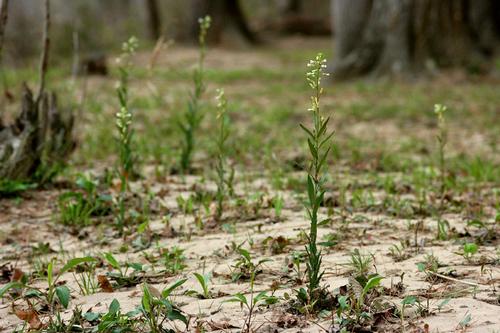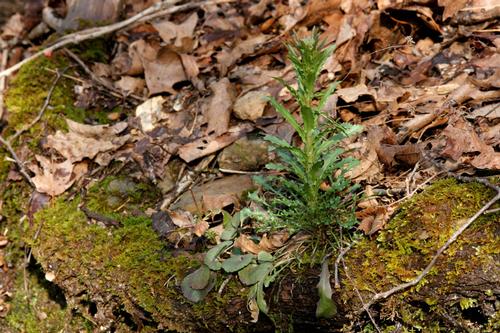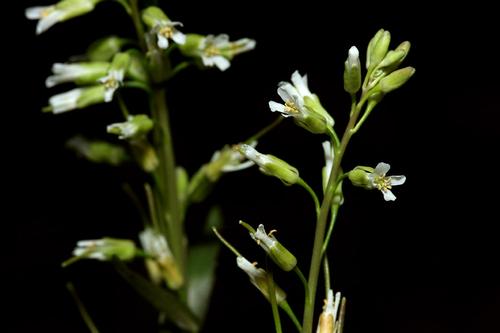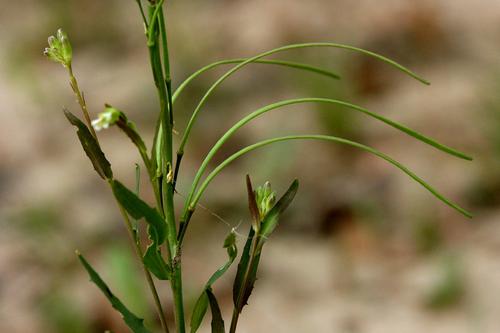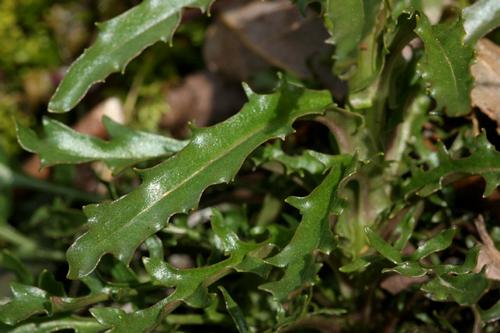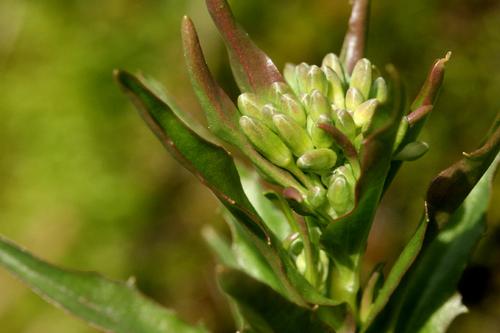Plants and Animals
Boechera missouriensis Missouri rock-cress
Key Characteristics
Green (not glaucous) biennial herb with creamy-white petals that are about twice as long as the sepals. Stalks (i.e., pedicels) of flowers/fruits ascending in early flower, then nodding in fruit. Fruit a long narrow seedpod. Stem with 15–45 leaves. Leaves appressed to ascending, lance-shaped to broadly oval-shaped, and with wings clasping around the stem. Lower stem leaves (i.e., lower cauline leaves) with a few sharp teeth; upper cauline leaves nearly entire. Rosette leaves persistent, toothed to deeply lobed. Plant at least sparsely hairy (i.e., pubescent) near the base with simple (i.e., unbranched) hairs.
This species could be confused with several other Michigan Boechera species and sometimes Arabis or Turritis species, but it can be readily distinguished if cauline leaves and fruits are available. The cauline leaves of B. missouriensis are clasping at the base, unlike those of B. canadensis (sickle-pod). The upper cauline leaves of B. missouriensis are hairless with few teeth, unlike B. dentata (rock cress). Boechera missouriensis has simple hairs unlike the star-split hairs (i.e., stellate hairs) of B. grahamii (rock cress), and there are no hairs on B. laevigata (smooth bank cress). To further distinguish B. missouriensis from B. laevigata, B. missouriensis has persistent basal rosette leaves, more cauline leaves, and lacks a glaucus color. The fruits of B. missouriensis are nodding or limp, unlike the strongly appressed and ascending fruits of B. stricta (drummond rock cress), Arabis pycnocarpa (hairy rock cress), and Turritis glabra (tower mustard). The fruits of T. glabra are also round.
Status and Rank
US Status: No Status/Not Listed
State Status: T - Threatened (legally protected)
Global Rank: G5 - Secure
State Rank: S2 - Imperiled
Occurrences
| County | Number of Occurrences | Year Last Observed |
|---|---|---|
| Allegan | 4 | 2018 |
| Barry | 1 | 1985 |
| Berrien | 1 | 1981 |
| Cass | 2 | 1950 |
| Clinton | 1 | 1890 |
| Ionia | 1 | 1890 |
| Kalamazoo | 5 | 1947 |
| Kent | 2 | 1898 |
| Lake | 2 | 2004 |
| Macomb | 1 | 1914 |
| Monroe | 2 | 1958 |
| Muskegon | 1 | 1950 |
| Oakland | 2 | 1916 |
| St. Joseph | 3 | 1950 |
| Wayne | 1 | 1990 |
Information is summarized from MNFI's database of rare species and community occurrences. Data may not reflect true distribution since much of the state has not been thoroughly surveyed.
Habitat
In Michigan, known from the southeastern, southwestern, and west-central portions of the Lower Peninsula in dry, sandy, open to semi-open uplands including savannas, fields, borrow pits, railroad rights-of-way, powerline cuts, oak-pine barrens, and black oak woods. It has even been reported from swamps, but those two records are old and vague, and presumably the specimens came from upland inclusions within the swamps.
Natural Community Types
For each species, lists of natural communities were derived from review of the nearly 6,500 element occurrences in the MNFI database, in addition to herbarium label data for some taxa. In most cases, at least one specimen record exists for each listed natural community. For certain taxa, especially poorly collected or extirpated species of prairie and savanna habitats, natural community lists were derived from inferences from collection sites and habitat preferences in immediately adjacent states (particularly Indiana and Illinois). Natural communities are not listed for those species documented only from altered or ruderal habitats in Michigan, especially for taxa that occur in a variety of habitats outside of the state.
Natural communities are not listed in order of frequency of occurrence, but are rather derived from the full set of natural communities, organized by Ecological Group. In many cases, the general habitat descriptions should provide greater clarity and direction to the surveyor. In future versions of the Rare Species Explorer, we hope to incorporate natural community fidelity ranks for each taxon.
Associated Plants
Big blue-stem (Andropogon gerardii), bearberry (Arctostaphylos uva-ursi), needle grass (Avenella flexuosa), sedge (Carex muehlenbergii, sedge (C. pensylvanica), star toadflax (Comandra umbellata), sweet fern (Comptonia peregrina), poverty grass (Danthonia spicata), quack grass (Elymus repens), flowering spurge (Euphorbia corollata), woodland strawberry (Fragaria vesca), hairy bedstraw (Galium pilosum), common St.-John’s-wort (Hypericum perforatum), shrubby St.-John’s-wort (H. prolificum), jack pine (Pinus banksiana), Kentucky bluegrass (Poa pratensis), old-field cinquefoil (Potentilla simplex), pasture rose (Rosa carolina), northern dewberry (Rubus flagellaris), sassafras (Sassafras albidum), common goat’s beard (Tragopogon pratensis), white oak (Quercus alba), black oak (Q. velutina), little bluestem (Schizachyrium scoparium), and mullein (Verbascum thapsus).
Management Recommendations
This species is likely threatened by invasive species, woody encroachment, and conversion of barrens to forests through canopy closure. The species would likely benefit from prescribed fire or mowing, canopy thinning, and treatment of invasive species. Multiple occurrences are within utility or transportation rights-of-way and could potentially be threatened by right-of-way maintenance activities such as herbicide application.
Survey Methods
Random meander search covers areas that appear likely to have rare taxa, based on habitat and the judgment of the investigator.
-
Meander Search
-
Survey Period: From third week of June to second week of July
-
References
Survey References
- Elzinga, C.L., D.W. Salzer, and J.W. Willoughby. 1998. Measuring and Monitoring Plant Populations. The Nature Conservancy and Bureau of Land Management, Denver. BLM Technical Reference 1730-1. 477pp.
- Goff, G.F., G.A. Dawson, and J.J. Rochow. 1982. Site examination for Threatened and Endangered plant species. Environmental Management 6(4): 307-316
- Nelson, J.R. 1984. Rare Plant Field Survey Guidelines. In: J.P. Smith and R. York. Inventory of rare and endangered vascular plants of California. 3rd Ed. California Native Plant Society, Berkeley. 174pp.
- Nelson, J.R. 1986. Rare Plant Surveys: Techniques For Impact Assessment. Natural Areas Journal 5(3):18-30.
- Nelson, J.R. 1987. Rare Plant Surveys: Techniques for Impact Assessment. In: Conservation and management of rare and endangered plants. Ed. T.S. Elias. California Native Plant Society, Sacramento. 8pp.
Technical References
- Gleason, H. A., and A. Cronquist. 1991. Manual of Vascular Plants of Northeastern United States and Adjacent Canada. 2nd Ed. The New York Botanical Garden, New York, New York.
- Haines, A. 2011. New England Wild Flower Society’s Flora Novae Angliae: a manual for the identification of native and naturalized higher vascular plants of New England. Yale University Press, New Haven, CT.
- Hanes, C. R. and F. N. Hanes. 1947. Flora of Kalamazoo County, Michigan: Vascular Plants. Privately published, Schoolcraft, Michigan.
- Reznicek, A. A., E. G. Voss, and B. S. Walters. 2024. Michigan Flora Online. University of Michigan. <http://michiganflora.net>. Accessed 4 January 2024.
- Wilhelm, G. and L. Rericha. 2017. Flora of the Chicago Region: A Floristic and Ecological Synthesis. Indiana Academy of Science, Indianapolis, IN.
- Yatskievych, G. 2006. Steyermark’s Flora of Missouri, Volume 2. Missouri Botanical Garden Press, St. Louis, MO.


